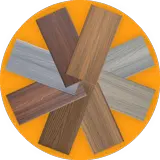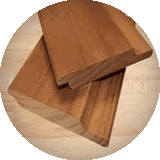Environment and benefits of plastic wood
wpc sample 05 With the escalation of environmental crises in recent decades, the foundation of the world’s biological resources has been exposed to serious dangers.
In this situation, all governments in order to achieve sustainable development to the best of their ability.
knowledge and technology to control the damage to the environment. uncontrolled harvesting of forests.
natural resources and reduce the amount of pollution imposed on the environment.
One of the most challenging issues in this area is waste and plastic waste.
These issues have led to many efforts in recent years to make composite materials based on the use of plastic waste and renewable sources.
including natural fibers. One of these types of products is plastic wood products, which are made by mixing thermoplastic and thermoset polymers with wood flour or fibers of other lignocellulosic materials. These materials have a wood-like appearance and in most applications can be used instead of wood and its products.
The use of various types of plastic waste, non-wood resources and non-consumable lignocellulosic wastes.
in addition to helping to protect forests, also has the double advantage of proper use of biodegradable plastic materials. Due to the severe shortage of forest resources and the growing need for wood products.
the purpose of this study is to identify the advantages of this type of multi-structures over other wood products. which has been tried by comparing their technical, economic and environmental properties. Emphasize the importance of replacing them in order to improve the consumption pattern of wood composite products.
Category: Plastic Wood
Author: mohsen ashoori

Keywords:
-Natural Resources Management
– Plastic wood composites
– Lignocellulosic fibers
– Waste
– Sustainable development
1. Introduction:
Considering the situation of the northern forests of the country , which covers only 7.5% of the country’s area. Its vulnerability is clearly shown, so the need to find a suitable alternative and rely on other resources and materials for the wood industry [2 and 1]. The lack of forest and wood resources in our country is a bitter and undeniable fact that consequently reduce capacity production even in cases.
There have been several closures of wood factories in recent years. According to studies, the environmental value of forests is up to 400 times their value in wood production (16).
According to the statistics of the Forests Organization. the exploitation of northern forests has decreased from 2 million and 200 thousand cubic meters to less than one million cubic meters during the last ten years. which means a fifty percent reduction in the supply of wood to the consumer market [1].
The technological advances of the present age, in fact. depend on the advances that have been made in the field of materials. and future development will depend on the available materials.
Among these, composite materials (multi-structures) represent the great steps that have been taken in the evolution of engineering materials as well as materials engineering [11].
which means that with the physical combination of two or more materials, in addition to efficient materials.
light and It is more durable than traditional materials such as wood, plastic and ordinary polymers.
but for any specific application, the required properties can be created in a special composite.
which is not possible even with the precise design of traditional materials.] 17
Environment and benefits of plastic wood
WPC composites “Composites or composites of plastic wood” are among the new engineering.
construction materials, that are developed and used by many specialists in various fields including polymer, materials science and engineering.
chemistry and chemical engineering, solid mechanics, material fracture mechanics, Wood, mathematics and computer engineering have made a significant contribution. Therefore, due to the wide range of topics, it seems impossible to discuss it in all aspects of the above sciences. But it can be said that this science / industry is primarily the result of cooperation and interaction between the two industries of polymer and wood industry with each other that the polymer industry has the knowledge of processing and manufacturing and the wood industry has the knowledge of raw materials and consumer market] Tajvidi 1384 [.60
The world’s first research and production of plastic wood products began in Western Europe in the early 1980s.
but in the 1990s it expanded at an astonishing rate in the United States to the point that experts today believe that the industry is scientifically and technologically advanced in Europe.
It is developing 10 years behind the United States, with Germany, Austria, Italy and the United Kingdom leading the industry in Europe [19].
WPC is a common term for two different types of composites. Products that are made by mixing thermoplastic polymers as matrices with wood fibers or other “cellulosic” materials as reinforcing phases or fillers are called plastic wood. 2007 [Amplifier phase is usually stiffer and stronger than the matrix phase. These two phases are connected by connecting the interface area or the common surface (Interface). The properties and conditions of this area have a direct impact on the efficiency of the composite and the main role of the matrix phase is to maintain the reinforcing fibers and transmit the force.
The most important limitations of plastic materials are: relatively high cost.
limited operating temperature, negative impact of moisture, especially during the production process, brittle fibers and finally recycling and non-degradability problems.
Therefore, in order to reduce the above-mentioned restrictions in the manufacture of petroleum plastics, other organic and inorganic materials are used; agricultural renewable cellulosic fillers and fibers are among these materials.
Less density, no erosion of machine surfaces, high distribution and filling, increased hardness, recyclability and brittleness of fibers in bends during processing are among the advantages of cellulose fibers [2, 8].
These products are widely used in the manufacture of flooring, fences, door and window profiles, automobiles, home appliances and a variety of water structures.
Sawdust is a typical example of a cellulose powder obtained by crushing and grinding raw wood and wastes from sawmills and other production units of the wood industry.
But the word powder cellulose is a more common term because it includes not only tree wood but also many plant products such as cereal stalks such as wheat, barley, rice and date branches, etc. [8]
2. Sources of supply of cellulose powders
In general, most plants that have woody stems or seeds, bark, kernels, etc. can provide cellulose.
but since ancient times and traditionally. tree wood as the most important source of sawdust and cellulose powder and Fibers are known and still used for these purposes.
but today, the reduction of forest resources in the world and, consequently, the increase in the price of timber in the world on the one hand and the pressure of environmental organizations and non-governmental organizations “NGO” on the other hand, experts and industry have to look for alternative and cheaper sources.
Another resource that has been considered and used for this purpose is agricultural waste.
which is burned and destroyed in large quantities every year, but today in many industries, including the industry of making compact boards, chemical industries, dough and Paper making, composite industry and … used as cheap raw materials.
This has been considered in the developed countries of Western Europe and the United States to such an extent.
that currently dozens of factories in these areas use only agricultural waste such as wheat and barley straw.
rice stalks and corn, etc. as raw materials. consuming these materials as a percentage of raw materials.
The amount of production of these materials in terms of weight is at least equal and at most up to four times the amount of production of the plant.
and about 50% of this amount reaches rural consumption (livestock and agriculture), about 10% is lost during collection and transportation. It goes, but about 30% of this amount is completely programmable for (industrial use) 16 and 8.
In our country, due to forest poverty and severe wood shortages and environmental pressures, the use of large-scale and industrial wood for crop production, in addition to being uneconomical and expensive, causes irreparable damage to the country’s natural and ecological resources.
Meanwhile, according to the statistics announced by the Ministry of Jihad Agriculture, a huge amount of agricultural waste in the country is burned or left unused in nature, which can be good sources for supplying raw materials for our country’s industries.
Lignocellulosic materials that are used as reinforcements or fillers worldwide today include the following based on their source of production:
1- Types of cellulose powders, fibers and wood flour prepared from various sources of solid wood. including fast-growing trees or surplus cuttings and branches of forest trees.
2- Fibers and powders prepared from agricultural wastes such as sugarcane bagasse, straw, straw, wheat stalks, rice and other grains, hemp, flax and pruning garden trees.
3- Fibers prepared from reprocessing of wastes such as newsprint and cardboard and wastes from paper and pulp factories or wood flour from wood industries such as furniture, sawmills, municipal wastes, etc.
Environment and benefits of plastic wood
3. The use of recycled materials in the manufacture of composites of natural fibers and plastics
In 1994, about 590 million tons of waste was generated in the United States, most of which was plastic and wood waste.
which provided a good opportunity for manufacturers of composite products using recycled materials, because cheap recycled materials are cheap. Made economic production possible.
In 2002, the factory, which is the largest producer of WPC in the United States. purchased 227 tons of waste per day and consumed the same amount in the production cycle [17 and 2].
in total, the wood-plastic industry in North America consumed about 204 million kilograms of plastic in 2001, of which 95%, or 193 million kilograms of recycled materials.
Environment and benefits of plastic wood
In the UK, about 5 million tonnes of plastic is consumed annually, and 2.8 million tonnes of plastic waste is generated each year, of which 0.5 million tonnes (about 15%) is recycled, making wood waste relatively difficult to calculate.
But it is estimated that the amount in the UK is 5 to 7 million tons per year, of which about 1 million tons are recycled [8 and 9] .
This industry, despite the great progress and increasing growth in the United States and Western Europe in recent years in our country is still young and is in the process of introduction and adaptation.
the market for these pr
oducts is being formed. Due to the volume of cellulosic and plastic waste, there is a potential for the manufacture and expansion of these composites in the country and it is clear that the growth of its production in the country and its faster growth in the future.
In 2006, the global WPC market reached 300 million tons, of which about 75% is related to construction, structural applications, and no other type of engineering material in construction and open areas has grown so much in the consumer market. ] 4 [.
4. The most important advantages of wood-plastic composites
In fact, wood-plastic composites look similar to wood, while increasing their efficiency. Low moisture absorption, sufficient resistance to oxidation, good resistance to insect and termite infestation, low weight and long durability, reduced shrinkage and shrinkage, desirable physical and mechanical properties, sunlight resistance and good thermal insulation in building structures from. The most important advantages of using wood-plastic composites are [14].
Long life, recoverability, optimal shaping, sawing capability, nailing, grating,
Proper polishing and painting ability and application of decorative coatings are also considered as useful capabilities of these composites. At the same time, it seems that the wood-plastic industry can partially solve the problem of stray plastics in all parts of the country [13].
The table below compares the properties of wood-plastic panels with five common wood panels. These panels included plywood, directional chipboard [1], particle board, hard fiberboard and medium density fiberboard [2]. Wood-plastic panels were prepared in 20 and 60% wood flour.
Environment and benefits of plastic wood
Investigating the mechanical properties of heavy polyethylene composites and rice stalks with levels of 15, 30 and 40% by weight and meshes 12-25 and 25-40, the research team concluded that rice straw can be used as a degradable and inexpensive organic enhancer used in the preparation of composite products. An increase of up to 30% in rice straw improves tensile and flexural strength, but a 40% increase in straw reduces tensile and flexural strength. Also, increasing the amount of rice straw in the composite product reduces the crack resistance to the control polymer.
In general, the composite product prepared from fine-grained straw flour shows better mechanical properties due to better adhesion to the ground phase. No interaction was observed between the two factors of rice straw weight percentage and particle size in the composite product. The use of an adapter as a coupler of rice straw to the polymer base phase causes a connection between the two phases, which improves the relative mechanical properties of the composite product [14].
5. Environmental issues
The escalation of environmental crises in recent decades has put the foundation of the world’s biological resources in serious danger.
in which all governments to the best of their ability, knowledge and technology to contain the damage to the environment; Improper extraction of natural resources and reduction of the amount of pollution imposed on the environment. If the endless human desire to develop and enjoy the gifts and resources of the earth is not restrained in a logical framework, it will undoubtedly cause the rapid depletion of the earth from these gifts and vital resources. One of the most challenging issues in this field is waste and waste materials, which can be said to be the product of consumption and technology development worldwide [2].
The progress and development of human societies on the one hand and the expansion of industries on the other have caused the earth to turn from waste and man into a waste production machine; The prevalence of consumerist culture as well as today’s human beings turning to the production and use of indestructible synthetic materials in nature also adds to the issue.
Due to the limited resources of the planet, thinkers have been forced to think about the future of this biosphere.
In recent years, large industrial projects for separation, processing recycling for reuse in the production process have been built or are under construction, the most important of which are: recycling waste paper to produce cardboard, recycling of plastic materials, recycling of worn tires, aggregate , collection and recycling of worn-out vehicles, recycling of various types of industrial waste and use of crop waste to produce products, energy and dozens of other designs and projects.
Environment and benefits of plastic wood
An example of a successful project in the use of agricultural materials is the company, which was established next to an olive oil factory and the waste of olive kernels that were previously discarded by this factory, also the use of relatively recycled plastics. 50-50 produces WPC composite product and thus, by establishing a factory, in addition to producing added value and creating employment, it turns two environmentally friendly and disposable materials into quality and widely used products [2]. Environmental conditions have created a renewed interest in the use of natural fibers.
Recycling and in terms of environmental conditions for introducing new composites to the market is of increasing importance. Environmental laws and consumer pressure have led manufacturers of materials and components to measure the effects of their products on the environment at all stages of the work. These points have led to a lot of work in recent years in the manufacture of composite materials based on renewable sources, including natural fibers.
Recently, the automotive industry has paid serious attention to the use of natural fiber composites as a way of serving the environment and at the same time observing economic issues.
Other applications are emerging in the construction industry, climatic conditions.
life and processing affect not only the structure of fibers, but also the chemical composition of fibers [13].
In this regard, Singleton et al. (2003) studied the mechanical strength of composites made of high density recycled polyethylene and linen fibers. The results showed that the measured mechanical properties are a function of the amount of fibers. Although in this study no comparison was made between materials made of recycled and raw polyethylene, but it was stated that raw or recycled polyethylene can not have much effect [18].
Therefore, many laws and regulations in different countries of the world are developed and implemented by governments to protect, preserve and reduce the destruction of natural resources. The most effective and wise measure and strategy is the reuse of waste and waste materials or recycling; This reduces the amount of industrial and municipal waste.
as well as preventing excessive pressure on natural resources to supply raw materials. Applying the word (dirty gold) to waste is not far-fetched.
In this regard, governments, organizations and economic institutions have each entered this field and have defined and implemented projects. In our country, due to the huge resources of bagasse, the study and compilation of projects designed with the aim of using bagasse as raw materials for industry is done and is being done. One of these projects is the use of waste from the sugar industry to produce a composite product of plastic wood, which due to the increasing volume of waste plastics and unused bagasse and poverty in the per capita forest resources, this particular case in our country Iran is very much Has [13].
Unfortunately, in our country, like in other parts of the world, the use of plastic materials has become widespread and then spread, and gradually all kinds of plastic bags have replaced paper bags in fruit and groceries. Every Iranian in his daily purchase receives at least two or three plastic bags from the seller.
which after an hour is sent to the trash and finally goes to landfills, in addition to the replacement of disposable plastic bottles _ called PET _ With glass bottles of milk and soft drinks and other types of liquids that we all still remember well.
has created conditions in the country that everywhere from the shores of the Caspian Sea to the desert, rivers and mountains and finally the Persian Gulf.
Everywhere we look we see how nature is polluted with these bottles made of non-degradable materials; Seeing floating bottles in all running water has become a familiar sight. It is clear that the collection and recycling of these harmful substances to the environment is the biggest environmental benefit of this action; If mixed with waste lignocellulosic materials, which in turn is an environmental hazard, the production of plastic wood-plastic composite product is a double and frequent advantage.
The research team (2007) investigated the effect of mixing method on the mechanical properties of wood-plastic composites made by two methods of mixing melt and dry, density 1 g per cubic centimeter and dimensions 35 × 35 × 1 cm and using heavy polyethylene waste obtained from Milk bottles and medium density fiberboard with weight ratios of 60, 70 and 80 percent flour, concluded that in both methods the maximum amount of bending modulus is obtained at the level of 70%.
The rest of the mechanical properties decrease with increasing the percentage of flour from 60 to 80%. In all similar compounds, the mechanical properties of wood-plastic composites made by dry method were generally better than the molten method [13].
6-Conclusion :
Considering that the per capita consumption of composite materials in the country is one tenth of the per capita consumption in developed countries.
the head of the Iranian Composite Institute and a faculty member of the University of Science and Technology:
The per capita consumption of composites in developed countries is 3 kg, while this per capita in our country is only 0.3 kg [Shukria 1384] and due to the large and growing market of global production and consumption (annually more than 6 million tons of composite materials worth $ 145 billion are consumed in various industries around the world [13 and 2].
Many advantages and applications of these products mentioned earlier and the potential of our country to produce a variety of wood-plastic composite products = (wpc); before we become one of the major importers of these products to the government, investors and researchers are suggested in order:
By supporting investors and adopting incentive policies for industries that consume recycled materials such as bagasse and waste plastics.
especially in vulnerable and deprived areas such as Khuzestan province, the government has established WPC production units for the private sector are generally considered light industries, and their products can be a variety of finished and semi-finished products such as WPC granules and raw plastic wood sheets for use in other industries – in addition to meeting domestic needs and preventing the outflow of currency for the import of wood and materials.
WPC composite can provide industry prosperity and high added value for the country by creating direct and indirect employment. In addition, reducing the (destructive and environmental) effects of waste will be another very important and valuable consequence of this action.
Investors (both domestic and foreign), production activists and relevant experts in the country are advised to explore the possibilities for investing and establishing WPC composite production lines.
based on economic studies and estimates, what seems to be that WPC manufacturing industries have high added value and many comparative advantages in the country.
in addition to the fact that its consumer market is a large market in our country and consequently global consumer markets.
Large regional markets should not be neglected. Pakistan and Afghanistan in the east, Iraq and Turkey in the west.
the former Soviet states in the north and the Arab Gulf states in the south, and even India and China are all.
They can be export destinations and we must guarantee our presence and survival by offering quality products before the market is conquered by competitors.
Finally, it is suggested that research institutes and universities define and carry out research projects on scientific-technical studies to identify potential facilities in other parts of the country.
including the possibility of using rice straw and husks. In the northern provinces of the country, the use of wheat straw and other grains in other places and even fibers from recycled paper and cardboard to produce this family of composite products.
In order to reach the desired point of production and consumption as soon as possible.
we will become one of the pioneers of this technology in the region and the world as soon as possible.
Environment and benefits of plastic wood
7. Sources:
[1] ابولفتحی ، م. Hamedinejad, A. The trend of fluctuations in wood production and the development of the country’s wood industry in the last half century.
Proceedings of the National Conference on Supply of Raw Materials and Development of Wood and Paper Industries in Azar 87.
University of Agricultural Sciences Natural Resources 40 pages
[2] Barzegar Shiri, M. Wood-plastic multi-structures undergraduate thesis. Shahid Rajaei University. Tehran 2007
[3] Dost Hosseini, K. Production technology and application of compressed wood panels. second edition. University of Tehran Press. 1386. 712 pages.
[4] Tajwidi, M. Proceedings of the First WPC Composite Conference, Faculty of Natural Resources, University of Tehran. Karaj June 2005
[5]. Hot water h. Fassihi M . A review of additives used in plastic wood composites from the collection of WPC composite seminar papers of Amir Kabir University of Technology, Tehran, June 2006.
[6] Torabi S. Investigation of technical and economic dimensions of bagasse granule production from the collection of WPC composite seminar papers of Amir Kabir University of Technology, Tehran, June 2006
[7] Garmabi H .. Lashkari Q WPC Composite Technology and Forming Machines from the Proceedings of the WPC Composite Seminar of Amir Kabir University of Technology, Tehran, June 2006
[8] Jazayeri, M. Properties and sources of natural fibers and their role in composite production WPC Composite Seminar Proceedings of Amir Kabir University of Technology June June 2006
[9] Word. Q: A study of wood-plastic market in Iran and the world.
a study of the potentials of the Iranian and world markets from the collection of WPC composite seminar papers of Amir Kabir University of Technology, Tehran, June 2006.
[10]. Noor Bakhsh.a. Hosseini’s friend. ک ج. لتیباری. A.
Hosseinzadeh Investigation of the effect of type and amount of cellulose fibers and process temperature on the properties of polymer wood fiber composites Iranian Journal of Natural Resources Volume 57 No. 4a.
[11] Journal of Polymer Science and Technology (from the first to the eighth issue) (Engineer Masis Akbarian) Composite Articles Collection
[12] Jazayeri, b. 2006. Comparison of wood-plastic properties with wood panels. Proceedings of the Wood-Plastic Conference. Amirkabir University of Technology. 10 pages
[13] Chahar Mahali, M., Kazemi Najafi, S., Tajvidi, M. 2007. The effect of mixing method on mechanical properties of wood-plastic composites. Journal of Polymer Science and Technology. Twentieth year. No. 4. pp. 361-367.
[14] Shakeri, A. Omidvar, a. F, Gorjani. 2006. Investigation of mechanical properties of heavy polyethylene composite product of rice stem straw. Journal of Agricultural Sciences and Natural Resources. Volume thirteen. Number six. February-March 2006.
[15] Kiani, A. 2006. Bonding agents extending the performance range of wood-plastic composites. Leave the magazine. No. 50. Pages 96-100
[16] Barzegar Shiri, M. Akhlaqi Amiri, Z. Use of crop residues for manufacturing composite products, National Conference on Clean Agriculture, Gorgan, May 2009
[17] Klyosov. Anatole. A. Composition of Wood–Plastic Composites: Coupling Agents, p160-200 .2006
[18] Singelton, A. C. N., Bailline, C. A., Beaumont, P.W.R., and Peijs, T. 2003. On the mechanical properties, deformation and fracture of a natural fiber/recycled. Polymer Composites. Composites: Part B 34: 519-526.
[19] Youngquist J.A., Myers G.E., Muehl J.H., Krzysik A.M. and Clemens C.M., W53705-2398, USDA Forest Service, Forest Product Laboratory, Madison, USA, 1994
Producing of Wood-plastic composite an inevitable way for preservation of forest and management of municipal wastes
*Barzegar shiri – Mostafa *Mohammadi – Hosein * Akhlaghi Amiri – Zeinolabedin
*MSc.Student, Dep. of Wood and Paper Sc. & Tech. Gorgan Uni. Of Agri. Sci. and Nat.Res.–Iran
Environment and benefits of plastic wood
Abstract
Increasing of environmental crisis in recent years has threatened. The world natural resources in this condition. all the government in the way of way of achieving sustainable development as much as possible. have allocated their technologies and knowledge for avoiding of environmental impacts.
extreme harvests of forests and natural resources and decreasing the amount of pollutions to the environment have started.
One of the most challenging problems in this area is the plastic residues and wastes
That is caused to many efforts in the way of composite production based on using of plastic wastes and biodegradable resources.
such as natural fiber to be made one of this products are wood-plastic composites. that is made by mixing of various thermoplastic and thermosetting resins with natural fibers.
These products have the similar characteristics as wood in most application can be used alternatively using of these plastic wastes and residues beside the helping to forest preservation is to producing of biodegradable product And with regard to the extreme shortage of natural resources and hence the raw material of the country.
the aim of this survey is the recognition of the advantage of these composite in comparison to the others with especial focus on technical.
economical and environmental properties in the course of modifying the consumption pattern of wood based composit.
Environment and benefits of plastic wood.
Click on the link below to view Van Wood projects
Also, click on the link below to know the price of Plast Van Wood








